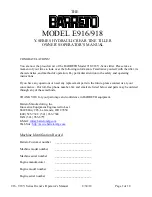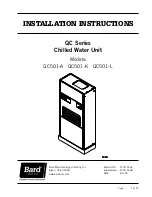
8
1.4 - repair safety considerations
All installed parts must be maintained by the personnel in
charge, in order to avoid deterioration and injury. Faults and
leaks must be repaired immediately. The authorised
technician must have the responsibility to repair the fault
immediately. After each repair of the unit, check the
operation of the protection devices and record their correct
operation in the maintenance log.
Comply with the regulations and recommendations in unit
and HVAC installation safety standards, such as: EN-378,
ISO-5149, etc.
If a leak occurs or if the refrigerant becomes contaminated
(e.g. by a short circuit in a motor) remove the complete
charge using a recovery unit and store the refrigerant in
mobile containers. The compressors do not allow to
transfer the refrigerant charge and can be broken if they
are used to pump down. The refrigerant charge should not
be transferred to the high-pressure side.
Repair the leak, detect and recharge the circuit with the
total R-1234ze(E) charge, as indicated on the unit name
plate. Certain parts of the circuit can be isolated. Only
charge liquid refrigerant R-1234ze(E) at the liquid line.
Always ensure you are using the correct refrigerant type
before recharging the unit. Charging any refrigerant other
than the original type (R-1234ze(E)) will impair machine
operation and can even lead to a destruction of the
compressors. The compressors operating with this refrigerant
type are lubricated with a synthetic polyolester oil.
RISK OF EXPLOSION:
Never use air or a gas containing oxygen during leak tests to
purge lines or to pressurise a machine. Pressurised air
mixtures or gases containing oxygen can be the cause of an
explosion.
Only use dry nitrogen for leak tests, possibly with an
appropriate tracer gas.
If the recommendations above are not observed, this can
have serious or even fatal consequences and damage the
installation.
Never exceed the specifi ed maximum operating pressures.
Verify the allowable maximum high- and low-side test
pressures by checking the instructions in this manual and
the pressures given on the unit name plate.
Do not unweld or fl amecut the refrigerant lines or any
refrigerant circuit component until all refrigerant (liquid
and vapour) as well as the oil have been removed from
chiller. Traces of vapour should be displaced with dry
nitrogen. Refrigerant in contact with an open fl ame
produces toxic gases.
The necessary protection equipment must be available,
and appropriate fi re extinguishers for the system and the
refrigerant type used must be within easy reach.
PROTECTION DEVICE CHECKS:
•
Periodic inspections of the safety devices and external
overpressure devices (external relief valves) must be
carried out in accordance with national regulations.
The company or organisation that conducts a pressure
switch test shall establish and implement a detailed
procedure to fi x:
•
Safety measures
•
Measuring equipment calibration
•
Validating operation of protective devices
•
Test protocols
•
Recommissioning of the equipment.
Consult Carrier Service for this type of test. Carrier
mentions here only the principle of a test without
removing the pressure switch:
•
Verify and record the set-points of pressure switches
and relief devices (valves and possible rupture discs)
•
Be ready to switch-off the main disconnect switch
of the power supply if the pressure switch does not
trigger (avoid over-pressure or excess gas in case of
valves on the high-pressure side with the recovery
condensers).
•
Connect a calibrated pressure gauge (the values
displayed on the user interface may be inaccurate
in an instant reading because of the scanning delay
applied in the control)
•
Neutralise the HP soft value
•
Cut the condenser water fl ow
•
Check the cut-off value
•
Reactivate HP soft value
•
Reactivate manually HP switch
CAUTION: If the test leads to replacing the pressure
switch, it is necessary to recover the refrigerant charge,
these pressure switches are not installed on automatic
valves (Schraeder type).
At least once a year, visually inspect the protection
devices (valves, pressure switches).
If the machine operates in a corrosive environment,
inspect the protection devices more frequently.
Check regularly for leaks and repair immediately. Ensure
regularly that the vibration levels remain acceptable and
close to those at the initial unit start-up.
After an equipment failure, carry out a refrigerant
analysis at a specialist laboratory. If required, change the
refrigerant following a procedure such as that described
in NF E29-795.
If the refrigerant circuit remains open after an
intervention (such as a component replacement, etc.):
• Seal the openings if the duration is less than a day
• If more than 1 day, charge the circuit with oxygen
free nitrogen (inertia principle).
The objective is to prevent penetration of atmospheric
humidity and the resulting corrosion.









































